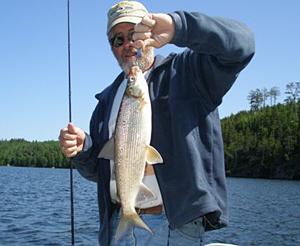Fish Chebak, Amursky ide, Siberian roach,soroga - the most used names. It is widely distributed in the rivers and lakes of Siberia and the Urals. Chebaku is indifferent to the scale of the reservoir. It can be a small river or a huge reservoir. As a rule, fish in any fish body prevail in numbers.

This species can be mined in industrial quantitiesdue to rapid reproduction and growth. As a rule, it is a small fish up to 30 centimeters long and weighing up to 600 grams, but individual specimens can reach 3 kilograms. It is believed that a large Chebaki can be caught only at night, for example, on the larva of the lamprey. The rest of the day catch only small and medium sized individuals. It feeds on larvae, algae, caviar of other fish, mollusks, higher plants and other organisms. Therefore, for fishermen, this is an easy prey, as the Chebak bites on dough, and on maggots, and on worms, and on greens, and on flavors, and on bread. This fish, as a rule, is fried or dried, and the fines go to fodder for poultry and cats. But many fishermen make from it a simple or triple ear directly on the shore of the pond, on fire, in a bowler hat.

Fish Chebak has an elongated shape of the trunk. Its color is often light with a greenish or bluish tinge. The back is darker than the abdomen. Scales - large, silvery, easily separated from the body. The fin on the back is tall, orange or red. On the upper part of the eye shell there is a small red spot - this is a distinctive feature. Nerestitsya fish Chebak begins in late March or early April, depending on weather conditions, and finishes in the first decade of May. Caviar is deposited on stony, vegetated areas of the bottom. One female can sweep up to 60,000 eggs that are attached to the stems and leaves of underwater plants. Having completed spawning, schools of fish go to the deep places of the reservoir, where they are fattened. Eggs develop over a couple of weeks. At this time, they form larvae, which reach the necessary phase of development and leave their house, rising to the surface of the water. There they eat hard, turn into small fish, which by autumn reach up to 5 centimeters in length. Chebak is a fish that reaches sexual maturity relatively long - only in the third year of life. At this moment its length is from 15 to 20 centimeters.

The fish lives in packs of fish. It's very easy to make photos, because these fish are not too shy. Flocks in summer actively ply throughout the reservoir of residence. But in June they are driven to shallow water places - for feeding. This time for the fishermen is the most effective. But in July the flocks begin to actively move again without a long peg to the places. This process continues until the fall. When the first frosts come, the Chebak begins to gradually move to the deeper parts of the reservoir. In winter, fish, like the whole family of cyprinids, are practically free of life. Chebak ceases to even eat. This fish is not an object of winter fishing. In spring, with the onset of heat, the Chebak again enters the activity phase, and the life cycle repeats again.</ p>






